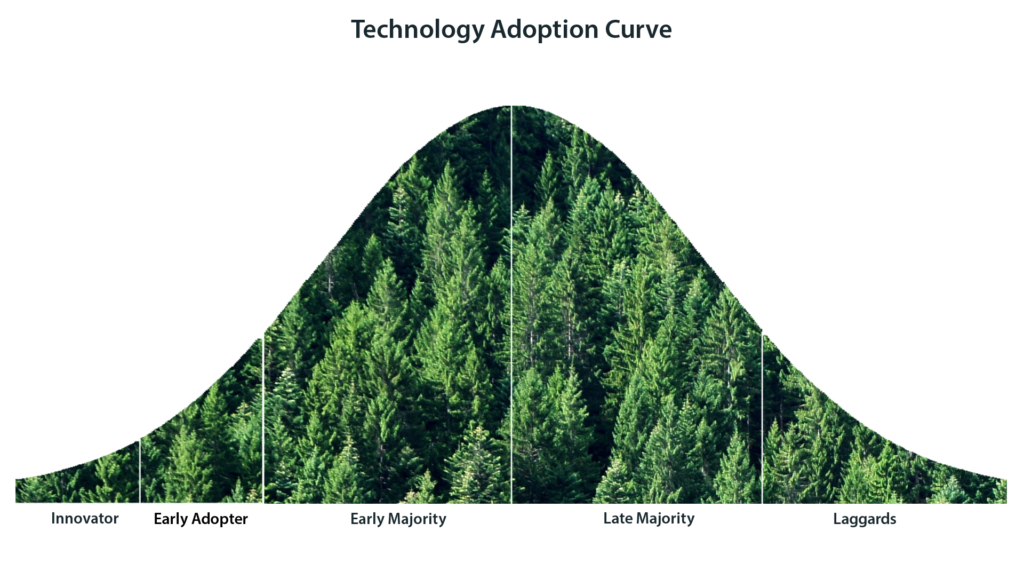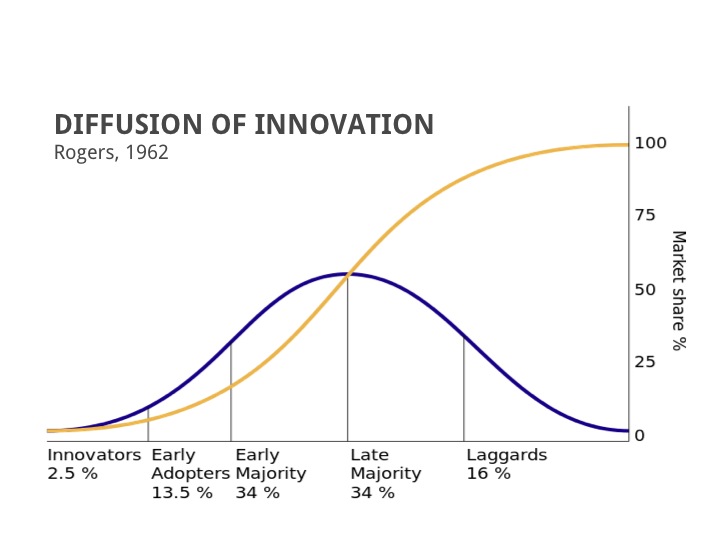Reprinted from “Gestalt Reinvention” by Schirtzinger W. R., High Tech Strategies, Copyright 2018 by Warren Schirtzinger. Reprinted with permission.
Gestalt Reinvention is a Two-Dimensional Model for Accelerating the Adoption of a New Technology, Product or Innovation
Introduction
Gestalt psychology is a school of thought that emphasizes the whole of anything is greater than its parts. That is, the attributes of the whole are not deducible from analysis of the parts in isolation. Using this as a foundation, Gestalt Reinvention Theory explains how innovations are taken up in a population, using the perspectives of BOTH the end user and the marketplace as a whole.
Definitions Related to Reinvention
The interesting thing about the technology business is that, most of the time, it’s not the technology that matters. What matters is how people react to it, and what new social norms they form.
When presented with a new innovation, most people are more interested in the market’s response to a product than in the product itself.
This characteristic of human behavior means that business leaders must be aware of the role the individual user plays, and also the role the market or the community plays. And the success of a new product is determined by both “adoption” and “diffusion.”
The established definitions of adoption and diffusion are an important part of the Gestalt Reinvention framework:
Adoption is the acceptance of a new idea or change by the end user. It is an individual process detailing the series of stages one undergoes from first hearing about a product to finally adopting it. And adoption is an individual or organizational process that leads to diffusion as a systemic process.
Diffusion, on the other hand, is the degree or level of adoption of new ideas or change by a population or market. It signifies a group process, which suggests how an innovation spreads among individual end users. In other words, how quickly the change gets accepted by a wide range of consumers is termed as diffusion.
Overall, the diffusion process essentially encompasses the adoption process of several individuals over time. Adoption is an individual or organizational process that leads to diffusion as a systematic or cultural process.
The Gestalt Reinvention Framework
The word “gestalt” means whole. Gestalt psychology is a school of thought that says humans are best viewed as a whole entity consisting of body, mind, and soul. When applied to innovation adoption the individual segments in the diffusion process are part of a greater whole and must be viewed as elements of a more complex system. “The whole is different than the sum of its parts.”
The main tenet of Gestalt Psychology is that people perceive the world in a holistic manner. In other words, our eyes may see the trees but our minds see the forest. We take in the details but our minds construct an understanding of the whole or “Gestalt” which can be independent and different than the sum of the parts.

Gestalt Reinvention amplifies and clarifies these two elements of innovation-adoption. Instead of focusing on persuading individuals to change, it sees change as being primarily about the evolution of both products and people, so that products become a better fit for the changing needs of individuals and groups.
People don’t often make their decisions by themselves with no input from others. We turn to family, friends, media, opinion makers, colleagues, etc. to get their input. This is particularly true of decisions which may impact on our safety or happiness to a great extent.
The Dynamic Duo of Gestalt Reinvention
The success of an innovation depends on how well it evolves to meet the needs of more and more demanding and risk-averse individuals in a population. And the benefits to society depend on how people change their behavior to accommodate and integrate the use of a new product.
Gestalt Reinvention increases the rate of adoption by increasing cultural compatibility, reducing complexity, enabling testing or exploration, and making the benefits of the innovation more observable.
A good way to achieve this is to make end users into partners in a continuous process of reinvention. Computer games companies, pharmaceutical companies and rural research institutes are all examples of organizations that seek to make users active partners in improving innovations by supporting user communities or by applying participative action research techniques.
Many computer games are now built with the intention that they will be modified by enthusiastic users. In this example of a low-risk consumer product, customers actually participate in the design of the game. This process of co-creation is even more important with high-risk B2B innovations.
Following the Right People
The interpersonal relationships between opinion leaders and followers hang in a delicate balance. If an opinion leader becomes too innovative, or adopts a new idea too quickly, followers may begin to doubt his or her judgment.
The key role of the opinion leader in the social system is to help reduce uncertainty about an innovation. To fulfill this role, the opinion leader must demonstrate prudent judgment when making decisions about adopting new ideas. So, the opinion leader must continually look over his or her shoulder and consider where the rest of the community is regarding new ideas.
The concept of reinvention is important because it tells us that no product or process can rest on its laurels: continuous evolution is the key to spreading an innovation.
Product Reinvention
Perhaps the best model to understand the need for product reinvention, so that an individual user is more likely to adopt, is the model of product perceptions.
Typically, when a new organization brings a new product (or service) to market, the initial users are intrigued with the tangible features of the product itself: its performance, its specifications, its size, color, shape, weight or even “footprint”. Moreover, the entrepreneurial team that conceived, developed and first sold the product is – by definition – often consumed by these tangible aspects. Tangible aspects of the product-at the time of introduction-often become the only focus of the development team.
But as the product moves from the lab to development to prototyping to alpha and beta testing to introduction and then to distribution and use, a subtle yet powerful change occurs. Tangible aspects of the product inevitably decline in importance and intangible aspects surrounding the product begin to emerge. In the early days, the overwhelming emphasis on product tangibles can be diagrammed like this:

Customers begin with an appreciation of the tangible product, but they soon appreciate more the aspects of intangibles surrounding the product-service and support, the image of the company, the nature of the underlying technology, or the reputation the product begins to build for reliability.
Intangible elements can be added to a product that has certain physical attributes, enhancing it with new dimensions that are often more valuable than the physical attributes alone. (see examples here)
The Diffusion Process
People don’t often make decisions by themselves with no input from others. We turn to family, friends, media, opinion makers, colleagues, etc. to get their input.
This is particularly true of decisions which may impact on our personal safety or happiness to a great extent.
And because decision making involves other people, you must account for the influence of others who are in the same social system or community.
Diffusion of Innovation (DOI) Theory, developed by E.M. Rogers in 1962, originated in communication to explain how, over time, an idea or product gains momentum and diffuses (or spreads) through a specific population or social system. The end result of this diffusion is that people, as part of a social system, adopt a new idea, behavior, or product.
The critical thing about the diffusion process is that it is almost entirely interpersonal. Only innovators are willing to rely on publications and sales representatives. Everyone else makes his or her decision overwhelmingly because of the example and the opinions of neighbors and peers.
As an innovation spreads from early adopters to mainstream audiences, face-to-face communication becomes more influential, and mass media or sales representatives become less influential.
The crucial elements in the diffusion process are (i) there is a new idea, (ii) which is communicated via certain channels (iii) among the members of a social system (iv) overtime.
The concept of dynamic reinvention is augmented and reinforced by the theory of the diffusion process. This means that both your interaction with a market or community, and the attributes of your product, must change together.
Summary
A major difference between the diffusion process and the adoption process is that diffusion occurs among persons while adoption is an individual matter.
For rapid acceptance and uptake of a new product, CEOs, entrepreneurs and change agents must focus on understanding the entire population or target audience, not just a sequence of adopter groups. And they need to account for how the use of a product spreads across users in order for the new product to have maximum impact.
The concept of Gestalt Reinvention offers three valuable insights into the processes of accelerating your new-product success:
- It describes the dual nature of innovation-adoption and describes the methods that make your new product or innovation spread.
- It explains the importance of viewing your audience or population as a whole, rather than a collection of individual segments.
- It teaches you how to discover the needs of individual adopters, AND the entire industry or population you serve.
The concept of product evolution is important because it tells us that no product or process can appeal to all end users throughout the product lifecycle.
The adoption process must be fully integrated with the diffusion process which is the spread of a new idea from its source of invention or creation to its ultimate users.
Continuous evolution through the addition of intangible attributes is the key to spreading an innovation through adoption. Whereas diffusion is the process by which innovative ideas are communicated through certain channels overtime among the members of a social system.



